
Kalakshetra premises
Due to semester examinations and summer vacation Kalakshetra – College of Fine Arts and Museum will be closed for visitors from 23rd March 2009 – 30th June 2009. Visitors are requested to contact College office after 1st July 2009 for further information.
The Kalakshetra performance is a hallmark of excellence, marked by simplicity, elegance, and formal rigor. The thorough education here aims to create the consummate performer, one who is adept in his or her art and has an understanding of the theoretical, literary and musical basis of the art form.
Kalakshetra offers a range of options for the needs of every individual interested in learning music, dance or art, from its schools to its college, to the flexible evening course options. Interested persons should read about the different divisions at Kalakshetra for learning: the College of Fine Arts, the Besant Theosophical High School, the Arundale School, and the courses available in bharata natyam, carnatic music and the visual arts.
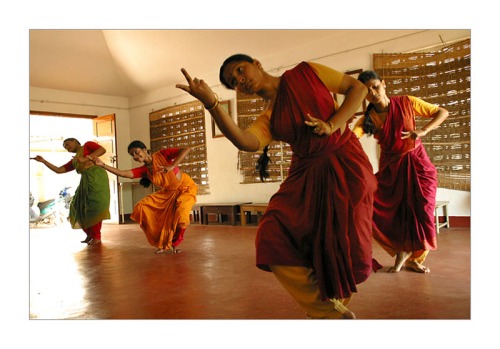
Students at Kalakshetra
Diploma
Dance
The intent of the institute is to create a consummate performer, one who is an adept dancer, and has a thorough understanding of the theoretical, literary and musical basis of the traditional margam. Therefore, language, music and theory are subjects that support the main subject of study. Each dance student must study vocal music or an instrument as a subsidiary subject. Dance students are encouraged to also study mridangam (a percussion instrument which accompanies the dance) in order to strengthen their understanding of tala or rhythm. Tamil, Telugu and Sanskrit, the languages most commonly found in the poetry of Carnatic music are part of the syllabus.
The Kalakshetra dancer is renowned for his/her impeccable form. One of Rukmini Devi’s most far-sighted changes to the dance was in the teaching of the basic steps or adavus of Bharata Natyam. She classified and broke down the various adavus, and refined many of the movements, giving them geometric precision with a touch of grace. Students are taught the adavus based on her systematized method for their first and most of their second years. Students are taught exercises and yoga, which aid and diversify the range of movement.
Items are gradually introduced into the curriculum from the second year onwards, and students begin learning abhinaya pieces from their third year. Students graduate from the four year diploma course with a strong theoretical, musical and language foundation which allows them to understand and incorporate new items into their repertoire, and, with continued practice and performance, to gain further insights into the dance form.
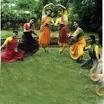
Students at Kalakshetra
Music
The intent of the institute is to equip students to become performers with strong foundations and the capacity for development on their own. The Kalakshetra diploma in music is unique in requiring 5 years of training, with 3 hours of main music class daily, more than any other comparable program. In spirit, the program emulates the gurukul system. Classes are small and individualized and the students’ progress is based on their strengths and on the discretion of the teachers. The teacher-student ratio is about one-to-four, with the teacher concentrating on the strengths and weaknesses of every student.
Teachers cover rare ragas and rare kritis wherever it will aid the student. They also cover works by all of the major composers, including compositions by those great gurus who worked at Kalakshetra, like Tiger Varadachariar, Mysore Vasudevachariar, Budalur Krishnamurthi Sastri, and M.D. Ramanathan, who all shaped the way music is taught here.
Voice culture is an important aspect of vocal music teaching, with regular sruti exercises, aakaram, and regular repetition of basic exercises in many raagas. This helps students to produce correct notes at quick speeds.
Every vocal student must take an instrument as a subsidiary subject, apart from other subjects like the theory of music, study of the lives of great musicians, and shastras related to music. They also do field trips to Thiruvaiyaru and other places of interest for carnatic music. Yoga is commonly taught to all students in Kalakshetra and two out of three languages are compulsory-Sanskrit, Telegu, and Tamizh.
If a student takes an instrument like veena, violin, or mridangam as their main subject, then vocal music becomes their subsidiary subject. Apart from this, they follow the same syllabus as the vocal student. It is also possible to take dance or art as a second subsidiary subject.
Drama, which is part of the legacy of Smt. Rukmini Devi, our founder, is seen and can be appreciated around the year in the many festivals and performances held in the institute. Kalakshetra has a repertory company that performs extensively through the year. Dance and music students of the institute have the benefit of listening to the music of great stalwarts and seeing the choreography of Rukmini Devi who was perhaps the greatest choreographer of the previous century.
Art
Art, dance and music, although of different disciplines, address the same sensibility; therefore, it is necessary that they all grow together in a cohesive environment of learning. The natural beauty and richness of the Kalakshetra campus is just the ideal setting for this Art, dance and music, although of different disciplines, address the same sensibility; therefore, it is necessary that they all grow together in a cohesive environment of learning. The natural beauty and richness of the Kalakshetra campus is just the ideal setting for this cohesive growth
The art centre provides students four-year diploma courses as well as short-term and part-time courses in the areas of visual arts including: art (painting), ceramics/pottery, sculpture and woodwork, design (basic visual design, textile, kalamkari, etc), and graphic art.
Courses of Study include a four-year diploma course (graduation program – residential), one-year short-term course (residential or day scholars), 1, 3, or 6 month short-term courses (day scholars), and part-time courses in the evening (day scholars).
For further detail, please contact the Registrar or Principal of Kalakshetra at 2452 1169 or email the Advisor of Fine Arts at artcentre@kalakshetra.in.
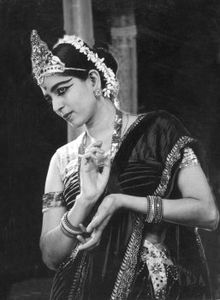
Rukmini Devi Arundale
Post Diploma Study in Music and Dance
Kalakshetra offers graduates who secure a First Class diploma the opportunity to apply for a further two-year post-graduate course in either music or dance.
Music students focus primarily on the practical, with a special focus on Raga Alapana, Pallavis, Padams, and other advanced studies. During this period, they have to write a dissertation, attend workshops and concerts of eminent artists and do field trips that may be related to their particular paper.
Dance students learn two new margams in the two year program. They study advanced theory, and have field trips with a view to writing a thesis. They also have the opportunity to perform in the dance-dramas and other productions of the Kalakshetra repertory.
Diploma/Post Diploma: Admissions
Interested applicants should read the following information on the applications and admissions process for the diploma course in Kalakshetra in music and dance, as well as other information available on this site about the College of Fine Arts and the Kalakshetra Foundation. The information provided will enable them to understand the range of resources available to every student.
Students between the ages of 15 and 25 who have passed the 10th standard are eligible for admission to the college. The prospectus and application form will be available on the web and in the College office in February of each year. The age restriction can be waived in the case of foreign applicants, after due consideration by a selection committee. The final decision will be taken by the Director.
Prospective students must submit their completed application with testimonials before May 18th. Applicants who are selected for the interview will receive an interview letter giving them the exact date and location of the interview. Interviews are held in the second week of June, a week before the college reopens. The interview is mandatory for all prospective students. Foreign nationals who require a student visa may be exempt from this rule at the discretion of the Director. For all others no changes to the interview date will be entertained. Students must pay for their own travel to and from the interview. Successful candidates must be prepared to join the institute within a week of the declaration of results which are made immediately after all interviews are completed.
The college opens in the third week of June and selected candidates must be prepared to join within a week. Students are selected on the basis of a practical aptitude test and an interview. The school seeks talented students who intend to become professional artists, and who will give the practice of their chosen art primary importance in their lives.
The first year is a probationary year for all students. Students must complete the entire course (four years in the case of Bharata Natyam and Visual Art and five years in the case of classical Carnatic music) in order to earn the diploma. In very special cases, direct admission to a higher class may be considered according to the training and qualifications of a student. However, a student will, regardless of this special consideration, have to undergo training for at least three years in order to qualify for a diploma in dance or art, and four years for a diploma in music.
International Students
Foreign students may apply using the Foreign Students Application Form. Visa and passport details have to be supplied to the College at the time of application. Students who wish to apply from foreign countries in advance or who apply through the Indian Council for Cultural Relations in their own countries must do so well in advance so that their applications can be processed in time for the new course. Such candidates must send their application form, school and college certificates, curricula vitae and a DVD of their work. Such candidates will be duly informed through email of the results.
Those foreign nationals who wish to take the interview in person will go through the same selection procedures as students from India. Those selected for entry into the college will be permitted to begin study only after obtaining the appropriate student visa.
Applicants selected for the interview under a tourist visa must obtain relevant information in their respective country of the rules that apply to the transfer of a visa from tourist status to student status. If students are selected for admission, Kalakshetra will issue a letter confirming their selection. This letter may be used to obtain a student visa, according to visa procedures which vary from country to country. For more information on visas, please contact the Indian consulate in your country.
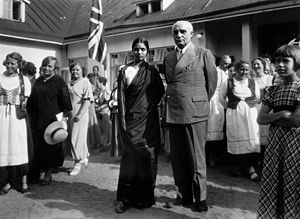
Rukmini Devi and George Arundale, Finland, 1936
The Indian Council for Cultural Relations (ICCR) has entered into agreements with certain countries, with a view to promoting cultural exchange between India and these countries. Students interested in learning in institutions and universities within India are given a scholarship for study, which cover tuition, lodging, board, and reimbursement of medical expenses. Prospective applicants to Kalakshetra from these countries must apply through the Indian Consulate in their country and indicate their preference for Kalakshetra in their application forms. The ICCR will forward their application to us for processing. As a government institute, Kalakshetra makes every effort to honor the Indian government’s commitments to other nations. However, Kalakshetra reserves the right to screen all applicants. For more information, please contact the relevant Indian Consulate.
Scholarships
A scholarship fund exists for students of Kalakshetra created from donations and endowments made to the institute. A limited number of scholarships are available to students whose parents or guardians are not in a position to pay their fees and who display a degree of talent and aptitude. The case of each applicant will be considered and decided by a scholarship committee. The scholarship covers the tuition fees alone, and for very deserving students, the hostel fees as well for an entire academic year. Scholarships are merit-based, and will only be made available to students with demonstrated financial need after their first year during which a student’s abilities can be judged.
Kalakshetra grants full scholarships to qualified candidates from any of the Northeast states of India.
Full time course fee details for 2009-10 at the Rukmini Devi College of Fine Arts of Kalakshetra

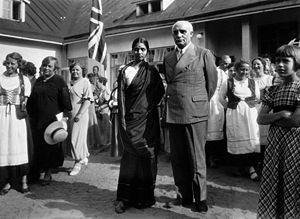
You must be logged in to post a comment.